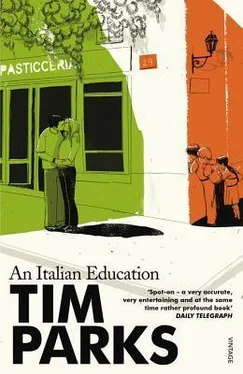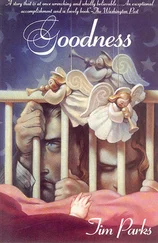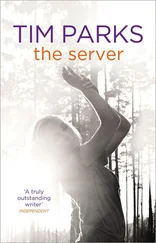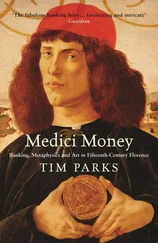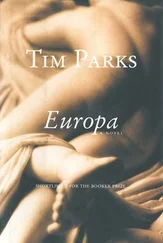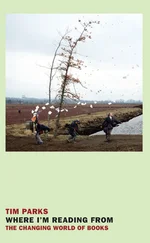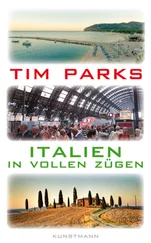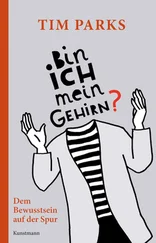Very early in the morning, I get a knock on my door. It’s Francesco with the bad news that there’s a damp patch rapidly forming on his bathroom ceiling. One of the pipes in my floor must be leaking. On the phone Righetti pretends incredulity. Hard to say ‘ naturalmente ’ to this one. And when I arrive back from the hospital with Rita and tiny Stefania, it’s to find that despite having taken up four floor tiles, the builder and his worker still haven’t found the problem. Apparently, no record was kept of exactly where the pipes were laid. In any event, they certainly weren’t golden. The men bang on the tiles with mallet and punch. The baby cries. Rita curses. On his way out in the late afternoon, Righetti takes the opportunity to remind me once again that I still haven’t paid the first month’s rent on the garage.
In the evening Stefano and Marta call with baby Beppe, to see both new house and new baby. And while I try to explain — and I feel almost apologetic — that we’ve decided it’s okay if the children put fingermarks on the paint in the kids’ room, which, of course, Michele already abundantly has, Stefano shakes a professional head over the rush job in the bathroom and wonders whether the floor can ever really be perfectly flat again. Once something has gone wrong… to put it right… sai com’è?
But the baby, Marta says, is a spettacolo — a spectacle, a show. Oh, she really is. Un vero spettacolo! It’s worth noting what positive connotations that word attracts in Italian. After all, what would Marta wish you to say of her own carefully kept house, her cotto floor and pietra serena fireplace, her lounge that she keeps locked shut to prevent Beppe getting at it, if not that it is uno spettacolo? Whereas my mother always used to say: ‘Tim, for heaven’s sake, don’t make a spectacle of yourself!’ Meaning, don’t draw attention to yourself. And meaning, little children should be seen and not heard, or better still neither seen nor heard.
Over the coming weeks and months, I’m afraid, it was my mother’s pejorative use of the word that turned out to be the most appropriate for our new baby. Stefi made a most awful spectacle of herself not just during the day but at one and two and three and four of almost every night and morning, moaning and wriggling and vomiting and never never never going to sleep. Every manual and magazine was consulted, every possibly dangerous element was removed from the mother’s diet, including artichokes and peperoni . One doctor even prescribed, as doctors notoriously will in the Veneto, that we give the child Valium. Whether this would have worked or not, I don’t know, for we baulked at that. Certainly, nothing else did. The nights were spent, as the Italians say, in bianco — in white — awake. Though wakefulness would be a flattering description of the semicomatose state in which I moved, night and day, over the coming months. For not only was I continually shattered from sleep by Stefi’s nagging scream, but likewise constantly narcotised by my wife’s ninne nanne , her lullabies. I remember listening endlessly to the one with the chorus that goes:
Ninna nanna, ninna nanna ,
La bambina è della mamma ,
Della mamma e di Gesù ,
La bambina non piange più …
Lullaby, lullaby,
The baby is mother’s,
Mother’s and Jesus’s,
The baby cries no more…
This turned out not to be true. Whether Mother’s or Jesus’s or both, the baby was still crying fiercely. In that near delirious state in which one drifts in such circumstances, I remember managing to feel irritated that the baby for which I was making such huge sacrifici appeared to be everybody’s but mine…
My wife sang:
Sorridi alla tua mamma amore
Che sempre veglierà per te.. .
Smile at your mummy, my love
She will always stay awake for you…
But this wasn’t true either. For as every parent knows, the person most susceptible to the soporific effect of a lullaby is the person obliged to sing it. Many a night Rita’s head would collapse red-haired on the pillow leaving that fellow never mentioned in any lullaby — Dad — to hold the baby and sing those more bizarre English songs that rather sadistically imagine babies swinging from precarious treetops.
To avoid singing for hours, one of the solutions we resorted to was a tape of lullabies. A languid southern croon offered some seriously sedative, even dirge-like pieces (most satisfactory) but inexplicably intercut with brighter, jollier things from unformed little girl voices backed up by an irritating accordion line of the kind one invariably picks up on the radio in Austria. This was entirely counterproductive, as if whoever had planned the tape wanted to put you to sleep only to wake you up again. Needless to say, there were no male voices.
How many times I listened to that cassette! One of the jollier songs told how the Madonna went off to market leaving Bambino Gesù with… guess who? Easier to guess who she didn’t leave him with, isn’t it? Lucky Giuseppe. No, she calls on a group of angels with incongruously Italian names who happily agree to babysit. But in her absence Jesus wakes and begins to squall. The angels try more or less everything we ourselves had been trying to get our own little baby back to sleep. Angelo Lilla tries camomilla . The angelo d’oro suggests a bel coro — a choir. Various other rhyming spirits propose easing off the swaddling clothes, massaging the little fellow’s tum, playing the violin, pulling faces at him, etc. But still the baby cries disperato , still the Madonna remains al mercato (grabbing a cappuccino if she was my wife). Finally, back comes Maria to announce that Gesù is just a smidgin hungry. She sends the angels off to market for something she has unaccountably forgotten, but by the time they get back with the goods the Son of God is, of course, asleep in the Madonna’s arms.
One says ‘the Son of God’, but minor details of this variety have no place in the endless Italian lullabies that feature the Virgin and her little boy. Very soon you begin to appreciate that, contrary to the Anglican tales I was told as a child at Sunday School, Jesus’s claim to prominence depends only very marginally on his being the Son of God and far more importantly on his having the Madonna for his mother. In any event, the only vitally defining factor about these two is that he is her bambino and she is his mamma . She has no other men after him and he no other women. This is what has remained sacred. Everything else is accidental.
But the lullabies I like most are the ones that allow the sad truth of their generative context to sneak into the lines themselves. The brutally simple ‘ Fa la nanna e la nanna faremo …’ (Go to sleep, then we can all go to sleep) is something I might well have made up myself around the end of the third week with Stefi. While rhyming bargaining gambits of the variety: Non fare più capricci / se no sarann’ pasticci (Come on, don’t fool about / or there’ll be trouble no doubt), followed up by the rather more threatening Alla tua mamma dài già tante pene / potrebbe creder che non le vuoi bene (You already make things so hard for your mother / she might end up thinking you don’t really love her), are the sort of thing I might have tried another week or so on. But the ninna nanna I finally began to identify with, say, by the end of a month or two, is the one that goes as follows:
Nanna O, nanno O
Il mio bambino a chi lo do?
Читать дальше
